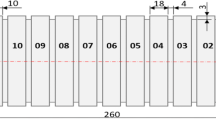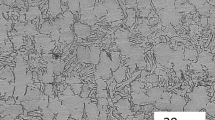Abstract
In this present research, a cryogenic machining system with adjustable jet temperature (− 196~20 °C) has been developed, and then a series of cutting experiments have been conducted to investigate the surface integrity of 35CrMnSiA high-strength steel under dry machining and cryogenic machining. The influences of cutting speed, jet temperature, and cooling condition on cutting force, surface roughness, microhardness, microstructure, and residual stress have been investigated. Experimental results are evaluated by means of a surface roughness tester, digital microhardness tester, digital microscope, and X-ray diffractometer. The experimental results reveal that the jet temperature, cooling condition, and cutting speed have a remarkable influence on the cutting force and surface integrity of 35CrMnSiA high-strength steel. At the same cutting speed, a reduction in jet temperature results in an increase in cutting force and decrease in microhardness. The lower jet temperature, the smaller the surface roughness. Compared with dry machining, the tensile residual stress can be effectively reduced under the condition of cryogenic machining. At the same jet temperature, as the cutting speed increases, the cutting force increases firstly and then decreases. In contrast, the surface roughness decreases firstly and then increases. With the increase of cutting speed, under the same cooling condition, the microhardness and residual stress shows a decreasing and increasing trend, respectively. This research contributes to providing a guide to optimize the machining process and improve machined surface integrity.
Similar content being viewed by others
References
Lee I, Bajpai V, Moon S, Byun J, Lee Y, Park HW (2015) Tool life improvement in cryogenic cooled milling of the preheated Ti–6Al–4V. Int J Adv Manuf Technol 79(1–4):665–673
Islam AKMK, Mia M, Dhar NR (2017) Effects of internal cooling by cryogenic on the machinability of hardened steel. Int J Adv Manuf Technol 90(1–4):11–20
Mia M, Khan MA, Dhar NR (2017) Study of surface roughness and cutting forces using ANN, RSM, and ANOVA in turning of Ti-6Al-4V under cryogenic jets applied at flank and rake faces of coated WC tool. Int J Adv Manuf Technol 93(1–4):975–991
Priarone PC, Klocke F, Faga MG, Lung D, Settineri L (2016) Tool life and surface integrity when turning titanium aluminides with PCD tools under conventional wet cutting and cryogenic cooling. Int J Adv Manuf Technol 85(1–4):807–816
Sartori S, Taccin M, Pavese G, Ghiotti A, Bruschi S (2018) Wear mechanisms of uncoated and coated carbide tools when machining Ti6Al4V using LN2 and cooled N2. Int J Adv Manuf Technol 95(1–4):1255–1264
Kim DY, Kim DM, Park HW (2018) Predictive cutting force model for a cryogenic machining process incorporating the phase transformation of Ti-6Al-4V. Int J Adv Manuf Technol 96(1–4):1293–1304
Danish M, Ginta TL, Habib K, Carou D, Rani AMA, Saha BB (2017) Thermal analysis during turning of AZ31 magnesium alloy under dry and cryogenic conditions. Int J Adv Manuf Technol 91(5–8):2855–2868
Ayed Y, Germain G, Melsio AP, Kowalewski P, Locufier D (2017) Impact of supply conditions of liquid nitrogen on tool wear and surface integrity when machining the Ti-6Al-4V titanium alloy. Int J Adv Manuf Technol 93(1–4):1199–1206
Xia T, Kaynak Y, Arvin C, Jawahir IS (2016) Cryogenic cooling-induced process performance and surface integrity in drilling CFRP composite material. Int J Adv Manuf Technol 82(1–4):605–616
Kaynak Y (2014) Evaluation of machining performance in cryogenic machining of Inconel 718 and comparison with dry and MQL machining. Int J Adv Manuf Technol 72(5–8):919–933
Trabelsi S, Morel A, Germain G, Bouaziz Z (2017) Tool wear and cutting forces under cryogenic machining of titanium alloy (Ti17). Int J Adv Manuf Technol 91(5–8):1493–1505
Li BX, Zhang S, Yan ZG, Jiang DD (2018) Influence of edge hone radius on cutting forces, surface integrity, and surface oxidation in hard milling of AISI H13 steel. Int J Adv Manuf Technol 95(1–4):1153–1164
Zhao T, Zhou JM, Bushlya V, Ståhl JE (2017) Effect of cutting edge radius on surface roughness and tool wear in hard turning of AISI 52100 steel. Int J Adv Manuf Technol 91(9–12):3611–3618
Pereira JCC, Rodrigues PCM, Abrão AM (2017) The surface integrity of AISI 1010 and AISI 4340 steels subjected to face milling. J Braz Soc Mech Sci Eng 39(10):4069–4080
Jr WVL, Melo ACAD, Oliveira AJD, Castro NA (2018) Effects of cryogenic cooling on the surface integrity in hard turning of AISI D6 steel. J Braz Soc Mech Sci Eng 40:15. https://doi.org/10.1007/s40430-017-0922-6
Tang LH, Gao CX, Huang JL, Shen H, Lin XJ (2015) Experimental investigation of surface integrity in finish dry hard turning of hardened tool steel at different hardness levels. Int J Adv Manuf Technol 77(9–12):1655–1669
Krolczyk G, Nieslony P, Legutko S (2014) Microhardness and surface integrity in turning process of duplex stainless steel (DSS) for different cutting conditions. J Mater Eng Perform 23(3):859–866
Zhang S, Li W, Guo YB (2012) Process design space for optimal surface integrity in finish hard milling of tool steel. Prod Eng 6(4–5):355–365
Umbrello D (2011) Influence of material microstructure changes on surface integrity in hard machining of AISI 52100 steel. Int J Adv Manuf Technol 54(9–12):887–898
Zhao W, Gong L, Ren F, Li L, Xu Q, Khan AM (2018) Experimental study on chip deformation of Ti-6Al-4V titanium alloy in cryogenic cutting. Int J Adv Manuf Technol 96(9–12):4021–4027
Fatima A, Mativenga PT (2015) A comparative study on cutting performance of rake-flank face structured cutting tool in orthogonal cutting of AISI/SAE 4140. Int J Adv Manuf Technol 78(9–12):2097–2106
Choi HJ, Park CW, Kang IS, Kim JS, Choi SD (2016) Material model application considering strain softening for cutting simulation of Ti-6Al-4V alloy and its experimental validation. Int J Precis Eng Manuf 17(12):1651–1658
Sivaraman V, Sankaran S, Vijayaraghavan L (2015) A study on the influence of cutting parameters on forces during machining the multiphase V-microalloyed steel. Int J Adv Manuf Technol 79(5–8):1285–1292
Kaynak Y, Lu T, Jawahir IS (2014) Cryogenic machining-induced surface integrity: a review and comparison with dry, MQL, and flood-cooled machining. Mach Sci Technol 18(2):149–198
Musfirah AH, Ghani JA, Che Haron CH (2017) Tool wear and surface integrity of Inconel 718 in dry and cryogenic coolant at high cutting speed. Wear 376–377:125–133
Umbrello D, Micari F, Jawahir IS (2012) The effects of cryogenic cooling on surface integrity in hard machining: a comparison with dry machining. CIRP Ann Manuf Technol 61(1):103–106
Hou GM, Li AH, Song XH, Sun H, Zhao J (2018) Effect of cutting parameters on surface quality in multi-step turning of Ti-6Al-4V titanium alloy. Int J Adv Manuf Technol 98(5–8):1355–1365
Wang FZ, Zhao J, Li AH, Zhao JB (2014) Experimental study on cutting forces and surface integrity in high-speed side milling of Ti-6Al-4V titanium alloy. Mach Sci Technol 18(3):448–463
Yang HC, Chen ZT, Zhou ZT (2015) Influence of cutting speed and tool wear on the surface integrity of the titanium alloy Ti-1023 during milling. Int J Adv Manuf Technol 78(5–8):1113–1126
Wang FZ, Zhao J, Li AH, Zhang HX (2014) Effects of cutting conditions on microhardness and microstructure in high-speed milling of H13 tool steel. Int J Adv Manuf Technol 73(1–4):137–146
Sun J, Guo YB (2009) A comprehensive experimental study on surface integrity by end milling Ti–6Al–4V. J Mater Process Technol 209(8):4036–4042
Wu CL, Ye BY, Deng WJ (2009) Effect of machining parameters on microstructure and hardness of ultra-fine grained material created by large strain machining. Mater Sci Forum 628–629:387–392
Umbrello D (2013) Analysis of the white layers formed during machining of hardened AISI; 52100 steel under dry and cryogenic cooling conditions. Int J Adv Manuf Technol 64(5–8):633–642
Yao CF, Tan L, Ren JX, Lin Q, Liang YS (2014) Surface integrity and fatigue behavior for high-speed milling Ti–10V–2Fe–3Al titanium alloy. J Fail Anal Prev 14(1):102–112
Pusavec F, Hamdi H, Kopac J, Jawahir IS (2011) Surface integrity in cryogenic machining of nickel based alloy–Inconel 718. J Mater Process Technol 211(4):773–783
Bermingham MJ, Kirsch J, Sun S, Palanisamy S, Dargusch MS (2011) New observations on tool life, cutting forces and chip morphology in cryogenic machining Ti-6Al-4V. Int J Mach Tools Manuf 51(6):500–511
Dhananchezian M, Kumar MP (2011) Cryogenic turning of the Ti–6Al–4V alloy with modified cutting tool inserts. Cryogenics 51(1):34–40
Outeiro JC, Pina JC, M'Saoubi R, Pusavec F, Jawahir IS (2008) Analysis of residual stresses induced by dry turning of difficult-to-machine materials. CIRP Ann Manuf Technol 57(1):77–80
Aspinwall DK, Dewes RC, Ng EG, Sage C, Soo SL (2007) The influence of cutter orientation and workpiece angle on machinability when high-speed milling Inconel 718 under finishing conditions. Int J Mach Tools Manuf 47(12–13):1839–1846
Funding
This research is financially supported by the Nanjing University of Aeronautics and Astronautics PhD short-term visiting scholar project under contract no. 190114DF05, National Natural Science Foundation of China under contract no. 51475234, and General Assembly Project under contract no. 9140A18030115HT90052.
Author information
Authors and Affiliations
Corresponding authors
Additional information
Publisher’s note
Springer Nature remains neutral with regard to jurisdictional claims in published maps and institutional affiliations.
Rights and permissions
About this article
Cite this article
Gong, L., Zhao, W., Ren, F. et al. Experimental study on surface integrity in cryogenic milling of 35CrMnSiA high-strength steel. Int J Adv Manuf Technol 103, 605–615 (2019). https://doi.org/10.1007/s00170-019-03577-6
Received:
Accepted:
Published:
Issue Date:
DOI: https://doi.org/10.1007/s00170-019-03577-6




